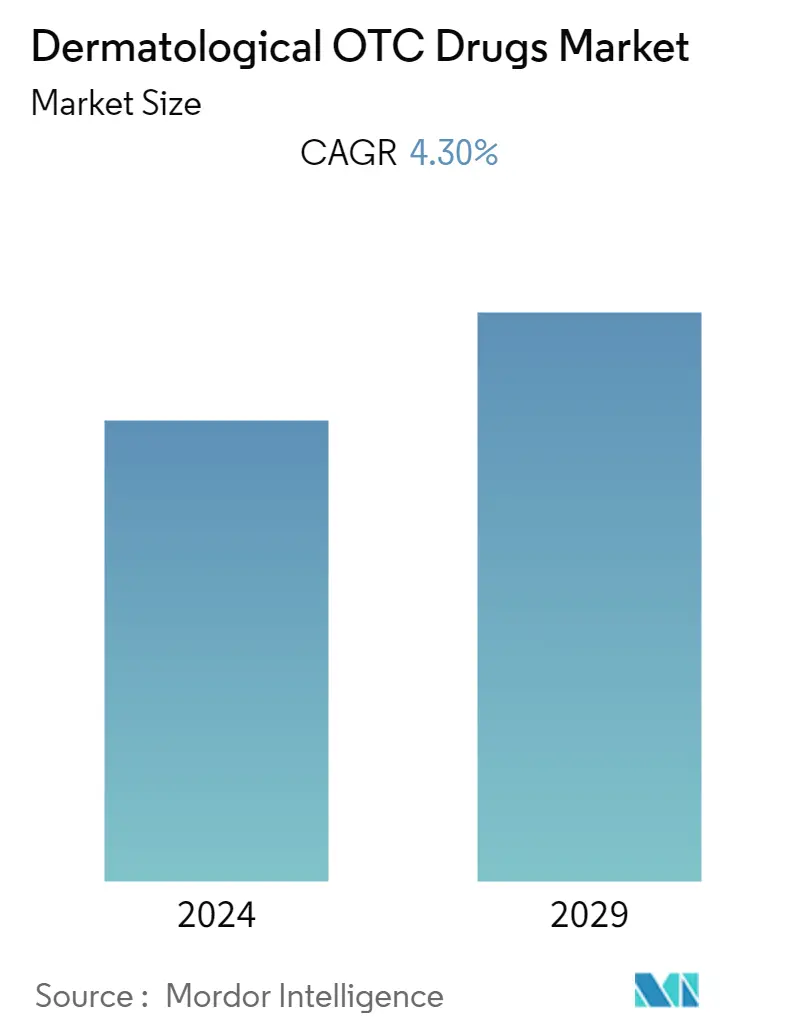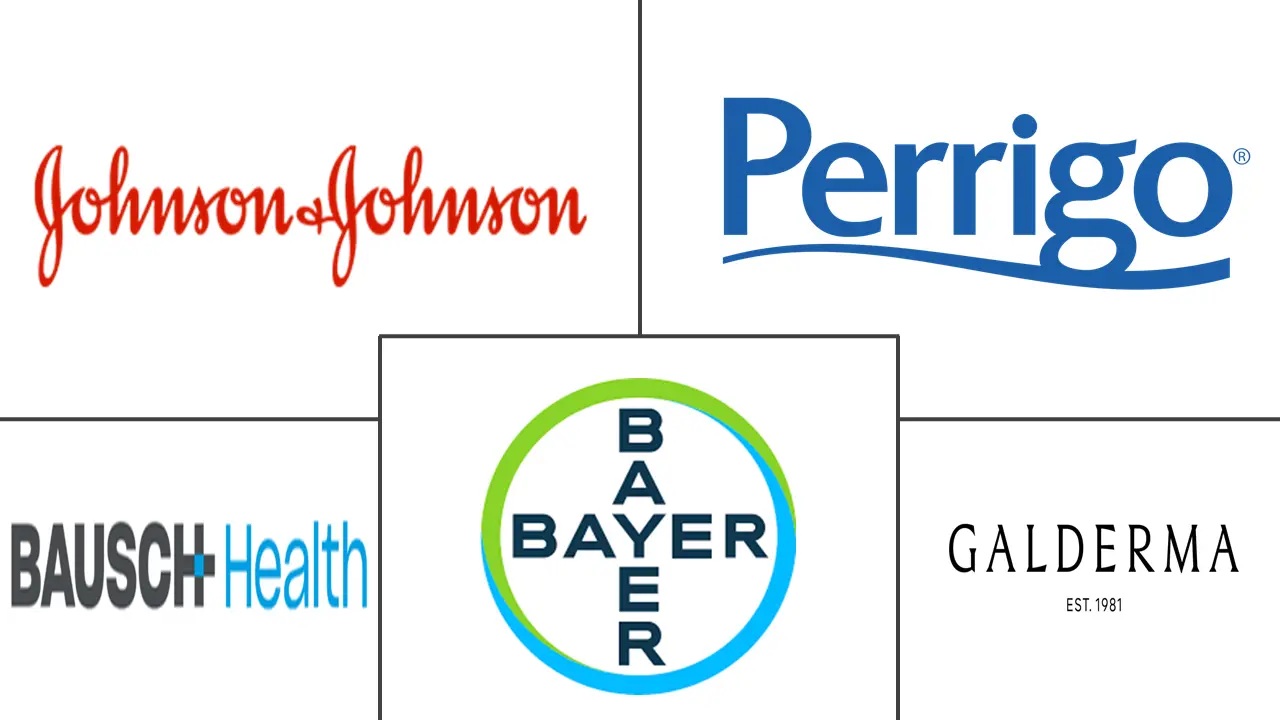Market Size of Dermatological OTC Drugs Industry

| Study Period | 2019 - 2029 |
| Base Year For Estimation | 2023 |
| Forecast Data Period | 2024 - 2029 |
| CAGR | 4.30 % |
| Fastest Growing Market | Asia-Pacific |
| Largest Market | North America |
Major Players
*Disclaimer: Major Players sorted in no particular order |
Dermatological OTC Drugs Market Analysis
The dermatological over the counter (OTC) drugs market is expected to register a CAGR of nearly 4.3% over the forecast period.
The COVID-19 pandemic had a significant impact on the studied market. Some studies reported that COVID-19 was responsible for dermatological conditions. For instance, according to the research study published by the National Library of Medicine in June 2022, the pandemic has caused a marked increase in stress-responsive dermatological conditions such as telogen effluvium, psoriasis, eczema, urticaria, and atopic dermatitis. Further, with the onset of telemedicine during the pandemic, there has been a significant increase in the demand for dermatological treatment. For instance, according to an article published by the National Library of Medicine, in May 2021, the COVID-19 pandemic had a huge impact on dermatology, as evidenced by the reduction of nonessential visits and procedures and the emergence of teledermatology. Teledermatology solutions have demonstrated the ability to enhance health outcomes during a high-stress period like the COVID-19 pandemic. Thus, the COVID-19 pandemic has significantly impacted the market initally, but later on with the emergence of telemedicine, the market witnessed a significant growth.
The major factor driving the growth of the studied market is the rising prevalence of skin-related diseases, the aging population as well as increasing demand and availability of dermatological OTC drugs. For instance, according to the research study published by the British Journal of Dermatology, in February 2021, skin diseases are the fourth most common cause of all human diseases, which affects approximately one-third of the global population. Hence, dermatological OTC drugs are gaining traction around the world due to increasing out-of-pocket expenditure. Besides, OTC drugs are not only cheaper than prescribed drugs, but also they are easily available and do not need any medical consultation. Thus, they offer a better alternative to the prescribed drugs which involves doctor's consultation with additional charges and expensive products.
Furthermore, increasing demand and availability of dermatological OTC drugs are expected to drive the growth of the market over the forecast period. For instance, according to an article published by Dermatology Advisor, in September 2022, there is an increase in the accessibility of OTC emollients for atopic dermatitis (AD) that resulted in cost savings by reducing hospital and outpatient visits along with prescription costs, and other care expenses.
Therefore, the factors mentioned above are attributed collectively to the studied market growth. However, side effects associated with the OTC medications are projected to hamper the market growth slightly over the forecast period.
Dermatological OTC Drugs Industry Segmentation
As per the scope of this report, dermatological over the counter drugs are referred to as non-prescription drugs. These medicines can be bought by an individual without a doctor's prescription and are safe for consumption without the doctor's consent. The Dermatological Over the Counter (OTC) Drugs Market is Segmented by Indication (Acne, Dermatitis, Psoriasis, Fungal Infections, and Others), Product (Tablets and Capsules, Oils, Gels, Creams, And Ointments, and Others) Route Of Administration (Oral and Topical), Distribution Channel (Hospital and Retail Pharmacies, Online Pharmacies, and Others), and Geography (North America, Europe, Asia-Pacific, Middle East and Africa, and South America). The market report also covers the estimated market sizes and trends for 17 different countries across major regions globally. The report offers the value (in USD million) for the above segments.
| By Indication | |
| Acne | |
| Dermatitis | |
| Psoriasis | |
| Fungal Infections | |
| Others |
| By Product | |
| Tablets and Capsules | |
| Oils, Gels, Creams, and Ointments | |
| Others |
| By Route of Administration | |
| Oral | |
| Topical |
| By Distribution Channel | |
| Hospital and Retail Pharmacies | |
| Online Pharmacies | |
| Others |
| Geography | ||||||||
| ||||||||
| ||||||||
| ||||||||
| ||||||||
|
Dermatological OTC Drugs Market Size Summary
The dermatological over-the-counter (OTC) drugs market is poised for steady growth, driven by the increasing prevalence of skin-related conditions and the aging population. The market has experienced significant changes due to the COVID-19 pandemic, which initially disrupted traditional dermatological services but later spurred growth through the adoption of telemedicine. This shift has enhanced access to dermatological care, contributing to the rising demand for OTC drugs. The market benefits from the cost-effectiveness and accessibility of OTC products, which offer a viable alternative to prescription medications that require medical consultations. The growing awareness and availability of these drugs are expected to further propel market expansion over the forecast period.
North America is anticipated to lead the global market, supported by a high prevalence of skin diseases and the presence of major market players. The region's market growth is bolstered by the easy availability of dermatological OTC drugs and ongoing product innovations. The acne segment, in particular, is expected to capture a significant market share due to the high incidence of acne and the convenience of OTC treatments. Company activities such as product launches, mergers, and collaborations are expected to enhance market dynamics. Despite the potential for side effects associated with OTC medications, the overall market outlook remains positive, with key players like Perrigo Company, Bausch Health Companies, and Galderma actively shaping the competitive landscape.
Dermatological OTC Drugs Market Size - Table of Contents
-
1. MARKET DYNAMICS
-
1.1 Market Overview
-
1.2 Market Drivers
-
1.2.1 Rising Prevalence of Skin-related Diseases and Ageing Population
-
1.2.2 Increasing Demand and Availability of Dermatological OTC Drugs
-
-
1.3 Market Restraints
-
1.3.1 Side Effects Associated With the OTC Products
-
-
1.4 Porter's Five Forces Analysis
-
1.4.1 Threat of New Entrants
-
1.4.2 Bargaining Power of Buyers/Consumers
-
1.4.3 Bargaining Power of Suppliers
-
1.4.4 Threat of Substitute Products
-
1.4.5 Intensity of Competitive Rivalry
-
-
-
2. MARKET SEGMENTATION (Market Size by Value - USD Million)
-
2.1 By Indication
-
2.1.1 Acne
-
2.1.2 Dermatitis
-
2.1.3 Psoriasis
-
2.1.4 Fungal Infections
-
2.1.5 Others
-
-
2.2 By Product
-
2.2.1 Tablets and Capsules
-
2.2.2 Oils, Gels, Creams, and Ointments
-
2.2.3 Others
-
-
2.3 By Route of Administration
-
2.3.1 Oral
-
2.3.2 Topical
-
-
2.4 By Distribution Channel
-
2.4.1 Hospital and Retail Pharmacies
-
2.4.2 Online Pharmacies
-
2.4.3 Others
-
-
2.5 Geography
-
2.5.1 North America
-
2.5.1.1 United States
-
2.5.1.2 Canada
-
2.5.1.3 Mexico
-
-
2.5.2 Europe
-
2.5.2.1 Germany
-
2.5.2.2 United Kingdom
-
2.5.2.3 France
-
2.5.2.4 Spain
-
2.5.2.5 Italy
-
2.5.2.6 Rest of Europe
-
-
2.5.3 Asia-Pacific
-
2.5.3.1 China
-
2.5.3.2 Japan
-
2.5.3.3 India
-
2.5.3.4 Australia
-
2.5.3.5 South Korea
-
2.5.3.6 Rest of Asia-Pacific
-
-
2.5.4 Middle East and Africa
-
2.5.4.1 GCC
-
2.5.4.2 South Africa
-
2.5.4.3 Rest of Middle East and Africa
-
-
2.5.5 South America
-
2.5.5.1 Brazil
-
2.5.5.2 Argentina
-
2.5.5.3 Rest of South America
-
-
-
Dermatological OTC Drugs Market Size FAQs
What is the current Global Dermatological OTC Drugs Market size?
The Global Dermatological OTC Drugs Market is projected to register a CAGR of 4.30% during the forecast period (2024-2029)
Who are the key players in Global Dermatological OTC Drugs Market?
Perrigo Company plc, Bausch Health Companies Inc., Johnson & Johnson, Bayer AG and Galderma are the major companies operating in the Global Dermatological OTC Drugs Market.

